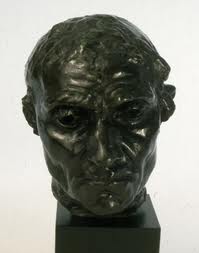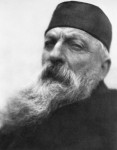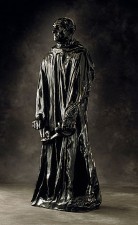
Auguste Rodin
French, 1840-1917
Head of D'Aire, 1886-1887
bronze with gilding
SBMA, Gift of Wright S. Ludington
1993.1.18

Rodin photographed in 1906 by Alvin Langdon Coburn.
"I invent nothing, I rediscover." - Auguste Rodin
RESEARCH PAPER
In 1885, Rodin won the commission from the city of Calais to create a commemorative monument recalling the valor of the six Burghers of Calais at an historic event during the 100 year war. The event happened In 1347 when King Edward III of England agreed to end the eleven month siege his forces had laid to that city on the condition that the citizens agreed to surrender six Burghers of the city to be sacrificed. Additionally, the men were to be dressed in sackcloth (a garment worn as a sign of penitence), to wear a rope harness, and to deliver the keys to the citadel. Rather than honor just the eldest member of the group, Rodin agreed to model all six for the same price.
To be able to bring this event to life, Rodin read books, revisited the site several times, and observed the people of Calais to find suitable human models. In portraying the Burgher's dutiful sacrifice, he had a chance to contemplate his own mortality--a subject he had been dealing with for some time during his creation of numerous other small figures for his famous doors known as the Gates of Hell. That death is inevitable was now a familiar subject for him. But in portraying it in a monument, he would revolutionize heroic monument making. His heroes would be shown as mortals, not as gods, and they would be grouped on a pedestal at ground level for viewers to walk among them and touch them instead looking at them on a pedestal four feet above everyone's head.
Jean D'aire is the figure who carried the keys to the citadel in the monument. Rather than making several keys, Rodin made one huge single key for him to carry with both of his hands. He stands at the back of the group, his bare feet firmly set wide apart, and his body seemingly pulled down by the weight of the key. In the head on exhibit, his eyes are deeply set with half lowered lids and are hooded by heavy brows casting shadows over them. His gaze is firmly fixed straight ahead. His large jaw is set with the chin pointed forward, and his tightly closed mouth is pulled down at each edge. The large nose and ears fit this six foot tall man. The hair is curly and extends over the large ears. It was said that Rodin used his son, Auguste Beuret, as the model for this powerful head.
The Santa Barbara Museum of Art has the bronze study for the head of Jean D'aire. In its face is illustrated the strength of character and the futility of resistance to the imminent death that awaits him. The anguish of the moment is reflected in the stare of the eyes as he faces his personal agony with stoic heroism. The deep eyes and sunken cheeks balance the other raised features to create areas of shadows and light that animate the face. The spiritual anguish that emanates from this face recalls earlier Gothic religious figures suffering persecution. Rodin had to reach deeply inside himself for the human gestures that would evoke strong responses from observers who would move among these individual heroes facing their moment of despair.
Prepared for the SBMA Docent Council by Eunice Drell, July 2003

Full body of Burgher of Calais with the head of Jean D'Aire
